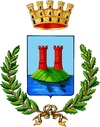Sestri Levante
| Sestri Levante | ||
|---|---|---|
| Comune | ||
| Comune di Sestri Levante | ||
 Skyview of Sestri Levante | ||
| ||
 Sestri Levante Location of Sestri Levante in Italy | ||
| Coordinates: 44°16′N 9°24′E / 44.267°N 9.400°E | ||
| Country | Italy | |
| Region | Liguria | |
| Metropolitan city | Genoa (GE) | |
| Frazioni | Azaro, Balicca Ponterotto, Cascine, Fossa Lupara, Ginestra, Libiola, Loto, Montedomenico, Riva Trigoso, Rovereto, San Quillico, San Bartolomeo, San Bernardo, Santa Margherita di Fossa Lupara, Santa Vittoria di Libiola, Tassani, Trigoso, Vignolo, Villa Arpe, Villa Campomoneto, Villa Carmelo, Villa Costa, Villa Costarossa, Villa Fontane, Villa Manierta, Villa Rocca, Villa Rocche, Villa San Bernardino, Villa Scorza, Villa Staffora, Villa Zarello | |
| Government | ||
| • Mayor | Valentina Ghio | |
| Area | ||
| • Total | 33.33 km2 (12.87 sq mi) | |
| Elevation | 1 m (3 ft) | |
| Population (31 December 2011)[1] | ||
| • Total | 18,177 | |
| • Density | 550/km2 (1,400/sq mi) | |
| Demonym(s) | Sestrini | |
| Time zone | UTC+1 (CET) | |
| • Summer (DST) | UTC+2 (CEST) | |
| Postal code | 16039 | |
| Dialing code | 0185 | |
| Patron saint | St. Nicholas and St. John the Baptist | |
| Saint day | December 6 and June 24 | |
| Website | Official website | |
| Wikimedia Commons has media related to Sestri Levante. |
Sestri Levante (Latin: Segesta Tigullorum/Segesta Tigulliorum) is a town and comune in Liguria, Italy. Lying on the Mediterranean Sea, it is approximately 56 kilometres (35 mi) south of Genoa and is set on a promontory. While nearby Portofino and the Cinque Terre are probably the best-known tourist destinations on the Italian Riviera, Sestri Levante is becoming quite a favorite among Italians. This once quiet fishing village is slowly turning into a tourist hotspot, developing an old and a new town.

Geography
Sestri Levante is found approximately halfway between Genoa and La Spezia. The town has two bays: Baia delle Favole, (Bay of the Fables), and Baia del Silenzio, the (Bay of Silence). The original part of Sestri Levante is actually on a peninsula, with the Baia del Silenzio (also known as "Portobello") on one side and Baia delle Favole on the other. Baia delle Favole or “Bay of Fairy Tales” was named in honor of Danish writer, Hans Christian Andersen, who lived in Sestri Levante for a short time in 1833.
History
Sestri Levante has its origins as an ancient maritime and merchant center. Originally a small island with a promontory, it was later connected to the mainland. In Roman times, it was known as Segesta Tigullorum (or Tigulliorum) or simply Segesta, but the place was nearly abandoned when the Roman empire collapsed. It seems to have belonged to the Ligurian tribe of the Tigullii.[2][3] It was mentioned again in the year 909 in a certificate of Berengar I of Italy, in which part of its territory was ceded to the basilica di San Giovanni di Pavia. During the Middle Ages, Sestri Levante began to expand, probably giving the fortress appearance that is due to the terrain.
In 1133, the noble family of Lavagna, the Fieschi, attacked Tigullio, the gulf in which Sestri Levante is located, however, they were fought off by the powerful Republic of Genoa, and therefore, Sestri Levante became a part of the republic, for military protection. In the year 1145, the abbey of San Colombano was acquired by the Genoese, and was transformed later into a castle.
In 1170, Sestri Levante was attacked by a naval flotilla from Pisa, but was able to withstand the attack.
Sestri Levante is mentioned by Dante Alighieri (as "Siestri") in Canto 19 of The Divine Comedy.
Sestri Levante is also a song by Australian band Tame Impala, and appeared on their album Live Versions.
Sister cities

The frazione of Riva Trigoso is twinned with:

Depiction in Rome: Total War
In the 2004 PC video game Rome: Total War, capturing Segesta (Sestri Levante) will always be the first mission the player receives if they have chosen to play as the Julii faction. The conquest of the city is thus often seen as a first step towards the expansion of the Republic by the player.
References
- ↑ All demographics and other statistics: Italian statistical institute Istat.
- ↑ Pliny. Naturalis Historia. 3.5.7.
- ↑

